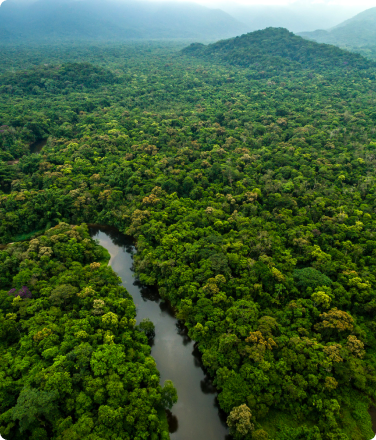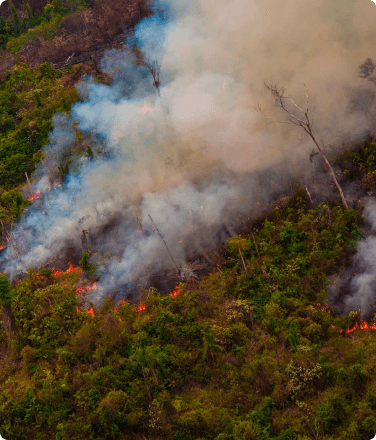King Reynaldo Santana of the Naso Tjër Di people leads a march to celebrate his peoples’ historic legal victory. Credit: COONAPIP
Panama’s Supreme Court awards the Naso people with title to 160,000 hectares (over 395,000 acres) of their traditional lands.
The Ruling: A Major Victory
In a major legal victory, indigenous peoples in Panama celebrate a land rights win sought for more than 50 years. In a sweeping resolution, the Supreme Court of Panama reaffirmed the legal rights to land and autonomy of the indigenous Naso Tjër Di people. The ruling also advanced the incorporation of international human rights law into the Panamanian legal framework and set a precedent for the titling of indigenous peoples’ lands that overlap nationally protected areas, opening new opportunities for the completion of the process of recognizing indigenous peoples’ land rights in the country.
After a two-year legal battle, on November 12, 2020, the Supreme Court finally ruled on the status of Law 656, creating a new autonomous indigenous province for the Naso people in northwestern Panama extending 160,000 hectares (over 395,000 acres), roughly half the size of Rhode Island. The Supreme Court’s decision was made more likely by the Ministry of Environment’s historic ruling in 2019, which affirmed that protected areas should not be a legal obstacle to collective land titling.
The Naso Tjër Di people of Panama came together celebrate the ruling of the country’s Supreme Court to create a new autonomous indigenous province for the Naso people extending 160,000 hectares (over 395,000 acres), roughly half the size of Rhode Island. Photo Credit: COONAPIP
The People: A Long Struggle
The Naso people, one of only two indigenous peoples in Panama with no legal rights to their ancestral lands, have been fighting for 50 years for legal recognition and legal security of their territory. Previous attempts to establish a comarca in 2003 and 2005 failed due to a lack of political will, despite significant international support from the World Bank.
In the 1980s, the Panamanian government created La Amistad International Park (PILA) and the Palo Seco Protected Forest, both of which overlap the Naso peoples’ traditional territories, without any consultation with the indigenous peoples living there.
Additionally, the construction of the Bonyik hydroelectric dam, which began operating in 2014, became another flashpoint in the Naso peoples’ struggle for their land rights due to its significant environmental and social impacts on the Naso people and the environmental integrity of the PILA park. Although the PILA was recognized by UNESCO as a World Heritage Site in 1990, threats to the park from illegal forest conversion and illegal occupation have continued to expand. Meanwhile, according to analysis done by the Rainforest Foundation US, deforestation rates remain lower on Naso lands than on the surrounding PILA protected area, demonstrating the effective conservation practices of the Naso people.
The Implications: Moving Forward
The importance of the recent Supreme Court decision extends beyond securing legal recognition for the Naso’s ancestral lands. It reaffirms the constitutional obligation of the Panamanian government to title and respect indigenous peoples’ lands and culture. It also reaffirms that “protected area” status of lands cannot be an obstacle to collective titling. Finally, it further incorporates international legal precedents in favor of indigenous peoples’ rights into Panamanian law, particularly the international obligation to respect the rights of indigenous people to lands that they have historically used and occupied. In fact, the Naso people’s ongoing complaints to the Inter-American Commission on Human Rights was one of the sources of pressure that propelled the Supreme Court to act.
The Naso people face a long road ahead as they proceed to demarcate their lands, negotiate their borders with their Ngöbe and Bribri neighbors, establish the complex governance arrangements necessary for an autonomous comarca, and strengthen their management systems for effective stewardship of their lands and forests. For now, they can continue this work with the knowledge that they have achieved the inalienable recognition of their ancestral territory.
RFUS’s Role and Response
For the Rainforest Foundation US, this victory comes as the culmination of two years of supporting mapping and monitoring training for Naso youth, building the strategic communications and advocacy capacity of the Naso leadership, supporting the strategic legal work in Panama and the international coordination with other international allies like the Land Rights Now coalition and Oxfam and the work with the Inter-American Commission on Human Rights. It is deeply gratifying to see those investments pay off in this landmark victory, which will secure rights for the Naso and other indigenous peoples in Panama.








